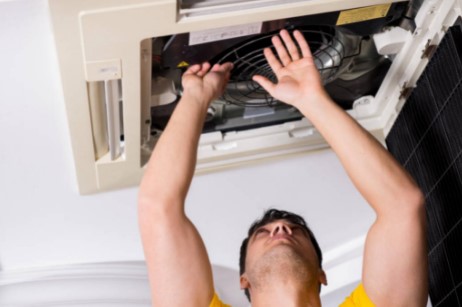HVAC dampers don’t have to be mysterious. You may be very aware of the fact that your HVAC system is composed of many different components that work together. However, you may not be familiar with the role played by dampers in keeping your home comfortable.
What exactly do HVAC dampers do? The short answer is that they keep hot and cold air balanced for optimal indoor temperatures. Dampers essentially regulate the flow of air inside your unit’s air-handling equipment to allow you to carefully control the flow of air throughout your home. In addition to keeping things comfortable today, dampers actually help to preserve the overall long-term health of your entire HVAC system. Staying on top of the state of your dampers can help you to enjoy a healthier, more comfortable, and more efficient home! Next, go deeper with dampers to understand just how important damper adjustments and maintenance are for the performance of your residential or commercial HVAC system.
All About HVAC Dampers
HVAC dampers are located inside your system’s ductwork. They are responsible for closing off ducts to help keep airflow balanced. Dampers shouldn’t be confused with registers. Unlike the registers that are found at the end of each duct run, dampers are actually located next to your central unit. That means that ducts are getting closed off closer to the source instead of next to walls, floors, or ceilings.
There Are Two Types of HVAC Dampers
Dampers can either be manual or motorized. When your system has manual dampers, you actually need to twist a screw that regulates airflow for specific zones. When your system has a motorized damper, the system will adjust on its own without your intervention. Self-adjusting dampers only come with what would be considered “premium” systems with zoned heating. Here’s a look at the steps for adjusting dampers when your system doesn’t automatically do it for you:
- 1. Turn on your fan.
- 2. Open the dampers all the way by turning the lever until it faces the same direction as your duct.
- 3. Open all registers to allow air to flow through the entire system.
- 4. Determine which ducts are connected to various rooms. This can be done by following each duct as far as it can go while observing the main unit. Verify which rooms are affected when you make adjustments by closing each damper one by one.
- 5. Be sure to label each damper once it has been properly identified.
- 6. Finally, it’s time to adjust your dampers. This will look different depending on the season. During the warm months, adjust your dampers to provide more airflow upstairs to combat rising hot air. Do the opposite in the cooler months.
- 7. Make adjustments based on your personal preferences.
- 8. Mark your “summer” and “winter positions” for easy reference when it’s time to balance your dampers again the next year.
Keep in mind that every HVAC system has its own unique guidelines for adjusting dampers. Use the manufacturer’s instructions before making any adjustments on your own. One important tip to remember is that you should never be closing any dampers completely. This will create unbalanced results that will leave your home uncomfortable. Yes, adjusting dampers on your own can be a lot of work. If you aren’t up for the task, it’s very easy to simply bring in HVAC professionals to adjust your dampers for you when it’s time to change your home’s airflow configuration with the changing of the seasons. In fact, many people like to combine their damper changes with their routine HVAC maintenance to keep everything working beautifully season after season.
How Do You Find Your HVAC Dampers?
If you have one of those premium systems discussed earlier, you won’t have any dampers to locate. The starting point for finding dampers on a system that requires manual adjustments is the furnace. Look for the main ducts that are leading away from the unit. Your dampers should be found right on the runs located within a few feet of the actual unit. Having trouble finding your HVAC dampers? It’s not uncommon. Call a local HVAC pro to help you locate exactly what you’re looking for.
Determining If Your HVAC Dampers Are Currently Open or Closed
This is another common problem that people run into when looking at their HVAC systems for the first time. There’s nothing intuitive about the appearance of open or closed dampers. You actually have to do some research to figure out what you should be looking for with your particular unit model. Here are the fast facts on how to identify your dampers:
- HVAC dampers are made of sheet metal.
- Dampers have small wing nuts on them.
- The wing nuts should have bolts that go right through the center. The flat spot that you see on the wing nut is important!
- The flat spot on the wing nut going through the bolt actually reveals the position of the damper.
- A horizontal flat head means that the damper is open. Turning the head at an angle will reduce the amount of air going through the duct.
- If the wing nut’s flat head is in the vertical position compared to the ductwork, the damper is closed.
Trying to figure out how to use dampers for the first time can be intimidating. This is why many homeowners decide to call in HVAC pros to assist with adjusting dampers. The good news is that getting dampers in the right position just one time will allow you to have the roadmap in place to adjust your dampers year after year on your own.
Do Motorized Dampers Ever Need Maintenance?
Yes! It’s possible for motorized dampers to malfunction. This is why damper inspections should be part of your routine HVAC inspection and maintenance plan. When a damper is functioning poorly, your entire home is at risk. A poorly operating motorized damper can cause poor air quality due to a lack of air circulation in your home. This puts you at risk for headaches, fatigue, dizziness, increased allergies, and other health concerns tied to poor indoor air quality in a home.
Beyond Dampers: Here’s Why You Might Be Having Hot Spots or Cold Spots in Your Home
What happens if you’re still getting uneven airflow after adjusting your HVAC dampers? While dampers can play a big role in keeping air circulating, they aren’t the only components that help to balance air in your home. Poor airflow can be caused by a number of different issues throughout a home’s HVAC system.
If you’re still experiencing unbalanced airflow in your home after adjusting dampers, the poor airflow may be a result of dirty air filters. Confirm that air filters have been recently changed before moving on. Next, it’s possible that a blocked air vent could be disrupting airflow. Confirm that all vents are clear from debris, large pieces of furniture, or personal belongings. Finally, it’s possible that there’s an air leak in your ductwork. The good news is that the fix might be as easy as having some duct sealing done in the areas where hot or cold spots are being felt in your home.
Get Help With HVAC Dampers in Newark Delaware
If you have any questions about your HVAC dampers, the team at Delaware Heating & Air Conditioning Service is here to help. Our licensed HVAC pros can help with damper inspection, manual damper adjustments, damper repairs, and damper replacements. Let us help you keep airflow balanced in your home for greater comfort, better efficiency, and improved ventilation. Contact Delaware Heating & Air Conditioning Service today!


Recent Comments